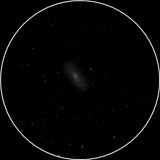
| MESSIER 110 |
|---|
RA: |
00h 40m 24s |
|
DEC: |
+41° 41' 00'' |
|
Type: |
Elliptical galaxy |
|
NGC: |
205 |
|
Magnitude: |
8.10 |
|
Surface brightness : |
14.00 |
|
Apparent dimensions : |
19.5'x11.5' |
|
Distance: |
2,500,000 ly |
|
Discovered by Charles Messier in 1773. M110 is the second brighter satellite galaxy of the Andromeda galaxy M31, together with M32, and thus a member of the Local Group. The small elliptical galaxy M110 is at about the same distance as the Andromeda galaxy M31, about 2.6 million light years.
It is of Hubble type E5 or E6 and is designated "peculiar" because it shows some unusual dark structure (probably dust clouds). M110 is now often classified as a dwarf spheroidal galaxy, not a generic elliptical one (this would make it the first ever known dwarf spheroid, of course). However, as it is much brighter than typical dwarf spheroids. M110's mass was estimated to be between 3.6 and 15 billion solar masses. Galaxy makes really nice group with M31 and M32 when viewed in low power telescope or binoculars. |
||
VEDRAN VRHOVAC© 2006.-2007. |
